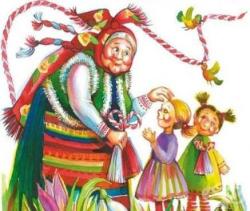|
| ‘Martenitsa’ and ‘Baba Marta’ – old Bulgarian Traditions |
|
|

Bulgaria Celebrates Traditional ‘Baba Marta’ Holiday with ‘Martenitsa’
Bulgarians celebrate on March 1 an old tradition of wearing and exchanging “Martenitsa” on what is called the day of Baba Marta. It is very loved and revered Bulgarian custom.
On this day tradition dictates to wear “Martenitsa“, made of twisted woolen or cotton thread. They are a symbol of health, longevity, fertility and abundance. The main colors of “Martenitsa” are white and red. White is a symbol of purity, innocence and joy. White are the festive clothes of the bride, saints and angels are also dressed in white robes. Red is the color of vitality, health and love fire. Red is the light of the rising and setting sun, of the flowing blood and of the fire. In traditional Bulgarian wedding the veil of the bride is red. Red thread is tied on fruit trees, on child’s wrist to protect against evil and to bring health. Such is its magical effect in the “Martenitsa“.
In the Rodopi Mountains “Martenitsa” are made of different colors. In Sofia and Melnik primary colors are blue and red. The blue color is the epitome of heaven and earth. The green color is a sign of fertility, health, renaissance festivity. Stitches involved in making “Martenitsa” are twisted necessarily left. Traditional Bulgarian “Martenitsa” includes various elements – symbols: snail shells (for health and strength), garlic (to prevent from evil demons), beads (against the evil eye), daisy (for well-being).
In the Bulgarian National folklore Baba Marta is a woman. Therefore it is variable in nature and the weather during that month is variable. When Baba Marta is angry the weather is cold, and when she laughs – warm and soft.
History and Legends
Legend of “Martenitsa” is associated with Ęhan Asparuh and the year of establishment of the Bulgarian State (681). According to one of these stories, when the Bulgars reached the Danube plain, they were enchanted by the place and decided to settle here. After the announcement of the newly established country the Khan wanted to make an offering to the god Tangra. Sacrificial pyre traditionally supposed to be lit with a sprig of dried dill, but Bulgars found no of this around. While wondering what to do, on the shoulder of the Khan perched falcon. On the bird’s foot hung bundle dill, tied with white thread, half colored red. It was sent by the sister of Khan Asparuh, Huba left in the palaces of their father Kubrat. Huba had a dream from which realized the difficulty of hes brother. With the falcon she sent a bunch of dill, tied with white woolen thread. During the long flight, however, the falcon’s wing was wounded and blood stained the white thread. So Asparoukh received wrist, laced with white and red thread. He lit the fire, according to tradition, but with the thread decorating for health. Since then on March 1 Bulgarians decorate their loved ones with twisted white and red thread.
Beyond the legend, there are suggestions that “Martenitsa” are legacy of the Thracians, indigenous peoples of present-day Bulgaria in antiquity. Reason for this assumption is that “Martenitsa” are typically Bulgarian symbol or of the heirs of the Thracian lands.
The Customs and Traditions of Baba Marta and “Martenitsa”
Some of the customs on March, 1 are related to the expulsion of evil spirits, including fires and burning garbage in the yard, and then all jump over the coals. A widespread custom is also to choose a day from first of March to March 22, each on his mind according to it, is judged what the year will be – if the day is sunny, it will be successful if it rains and the weather is bad – there will be difficulties.
According to an ancient legend, “Martenitsa” brings health, happiness and longevity. Old Bulgarians believed that in nature there is some evil force called the “badness” that also wakes up in the spring and in folk beliefs March 1-st marks the beginning of spring. On “Martenitsa” were attributed magical powers to prevent “badness”, mostly from disease and evil eye. It should be taken off right when seeing the first stork and should be hung on a blossoming or green tree.
Outside the Bulgarian ethnic territory “Martenitsa” are found in certain areas of Romania and Moldova (Mărţişor), Northern Greece (marti), Republic of Macedonia (martinka), Albania (monyak), or in places where Bulgarians lived or live in compact groups.
For more interesting stories about the Bulgarian culture and traditions, click here.
Happy ‘Baba Marta’ to all, wishing you health, longevity and good luck!
|
|
|
Source:
central-hotel.com
|
| Thursday, Feb 27, 2020 |
|
|
|
|
| » RENTALS |

|
|
|
| Office Space |
€ 255 |
|
| Location: |
Veliko Tarnovo |
|
|

|